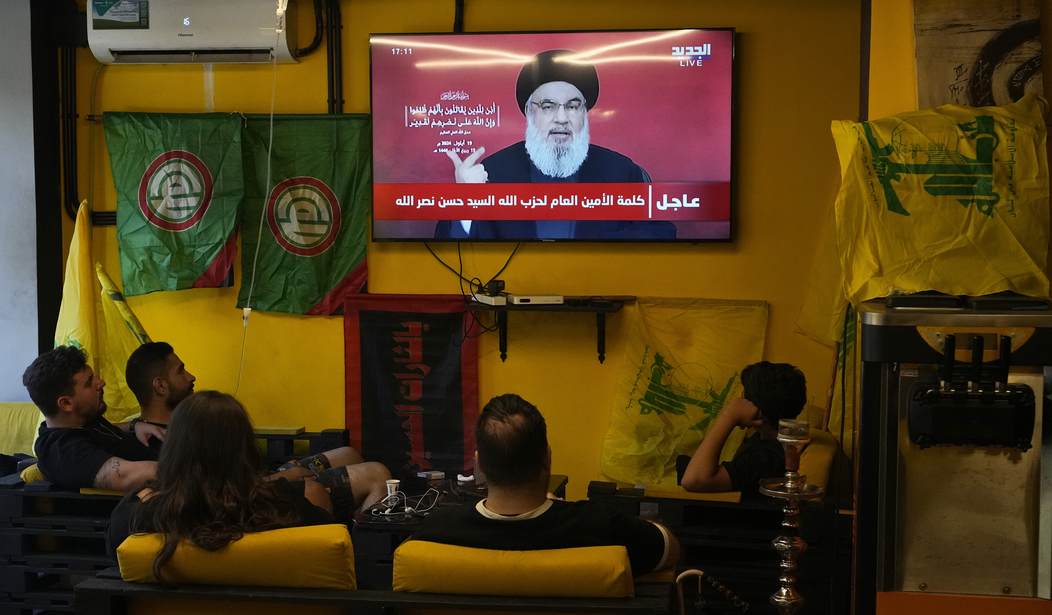As payback for Pagercide, it's weak sauce. As a demonstration of capability, today's attack on Tel Aviv may be more concerning.
Israel and the West knew for years that Hezbollah had acquired ballistic-missile capability. Today, they launched a Qadr-1 at Tel Aviv, their first use of a ballistic missile and a potential new phase of the long war between Hezbollah and Israel. The missile got intercepted by Israel's defense system, while Hezbollah claimed it as their response to Operation Grim Beeper:
The surface-to-surface missile was Hezbollah’s first-ever rocket attack on Tel Aviv, and is believed to be the first ballistic missile the terror group has ever launched into Israel. No injuries were reported in the missile strike, which was intercepted by the David’s Sling missile-defense system and came a day after President Joe Biden implored Hezbollah and Israel to de-escalate tensions. More on Biden’s address to the U.N. below.
Less than two hours later, the IDF confirmed that it had taken out the missile’s launcher in Nafakhiyeh, in southern Lebanon.
The Iran-backed terror group later confirmed that the weapon — a Qadr 1 ballistic missile likely obtained from Iran — had been targeting the Mossad’s headquarters. The strike came a week after a series of pager and walkie-talkie explosions killed dozens of Hezbollah members across Lebanon, and a day after a series of Israeli strikes hit targets across southern Lebanon, killing more than 500 people, including Ibrahim Kobeis, a senior commander in the group’s rocket and missile unit. A Hezbollah official told Reuters that the pager and walkie-talkie attacks had taken 1,500 of the terror group’s members out of action.
That number sounds very low, especially after Lebanese health officials put the number of wounded at more than double that number after the first day. Hezbollah has plenty of reasons to minimize their incapacities following that humiliation at the hands of the Mossad -- or their presumed hands, anyway. The Israelis have kept mum on their role in Pagercide, and likely won't ever take credit for the operation except in someone's memoirs a decade or more from now.
The source of those pagers and the nature of the operation makes that pretty obvious to everyone else, though. Hezbollah had to offer some kind of response that escalated from their normal level of attacks on Israel to save at least a little face. The use of a ballistic missile certainly escalates at least incrementally, but not by much. Firing off only one all but guaranteed that the David's Sling anti-ballistic missile system would track and neutralize the Qadr-1, which Hezbollah claimed to have aimed at Mossad headquarters in a town near Tel Aviv. Given the threats before the pager/radio attacks of massive escalation, this looks like a relatively impotent response. It may also be a good indication of how much Israel has degraded Hezbollah's capabilities over the past week-plus, both in men and in missile inventory.
Still, Seth Frantzman warns at the Jerusalem Post, the target itself indicates an escalation of ambition by Hezbollah and can't be taken lightly. The shift intends to restore some morale to the ranks, as well as attempt to offer some deterrence against a full-scale IDF invasion:
Now, Hezbollah is upping its claims and its targets. Hezbollah appears proud of using a single ballistic missile in the September 25 attack. Hezbollah supposedly has an arsenal of 150,000 rockets, but some have been destroyed by Israel’s airstrikes. It has lost some of its medium and long-range missile capacity. It has also lost the ability to launch some of the rockets. Hezbollah still has precision-guided munitions and large numbers of drones.
It appears Hezbollah is not ready to unleash a large barrage against central Israel. It prefers small attacks using one missile, as in today’s case, or barrages of five or ten rockets targeting areas east of Haifa. Hezbollah also continues to keep up the image of targeting IDF sites and thus carrying on a “military vs military’ war. It wants to show it can go toe-to-toe with the IDF.
This is an illusion, but Hezbollah wants to maintain the illusion. For now, it has sought to increase the equation of launching deeper attacks into Israel as a new normal to confront Israel’s increased attacks in Lebanon.
In other words, both sides are taking a page out of Vladimir Putin's playbook. "Escalate to de-escalate" is a classic Russian strategy, but it rarely works. In this case it doesn't even really make sense, given Hezbollah's general organizational aims and that of its patron, Iran. They want to destroy Israel, seize its land, and enslave the Jews that manage to survive. In historical terms, they want a return to Ottoman-style empire in the Levant, only with Persians rather than Turks in charge. Israel has tried to ignore that for the fantasy that it is, but after October 7, they can't ignore it or appease it any longer. Either Hezbollah and Hamas have to fundamentally change or they have to be destroyed, and now everyone knows that. Escalating as quickly as Israel has in this new phase of the war still leaves a little room for Hezbollah to throw in the towel, but only just. Israel clearly wants a resettlement on the basis of the 2006 orders to demilitarize southern Lebanon at a bare minimum, and preferably the destruction or expulsion of Hezbollah from Lebanon altogether.
Of course, the UN Security Council ordered the demilitarization of southern Lebanon as a settlement of the 2006 war between the same combatants. They then stood by and watched for 18 years as Hezbollah rebuilt its military capacity and launched missiles into Israel on a regular basis. This war is on them, and on their pusillanimous posture toward terrorism, refusing to enforce even that weak settlement. The UN spent this week castigating Israel for refusing to trust them enough to get betrayed another time.







Join the conversation as a VIP Member